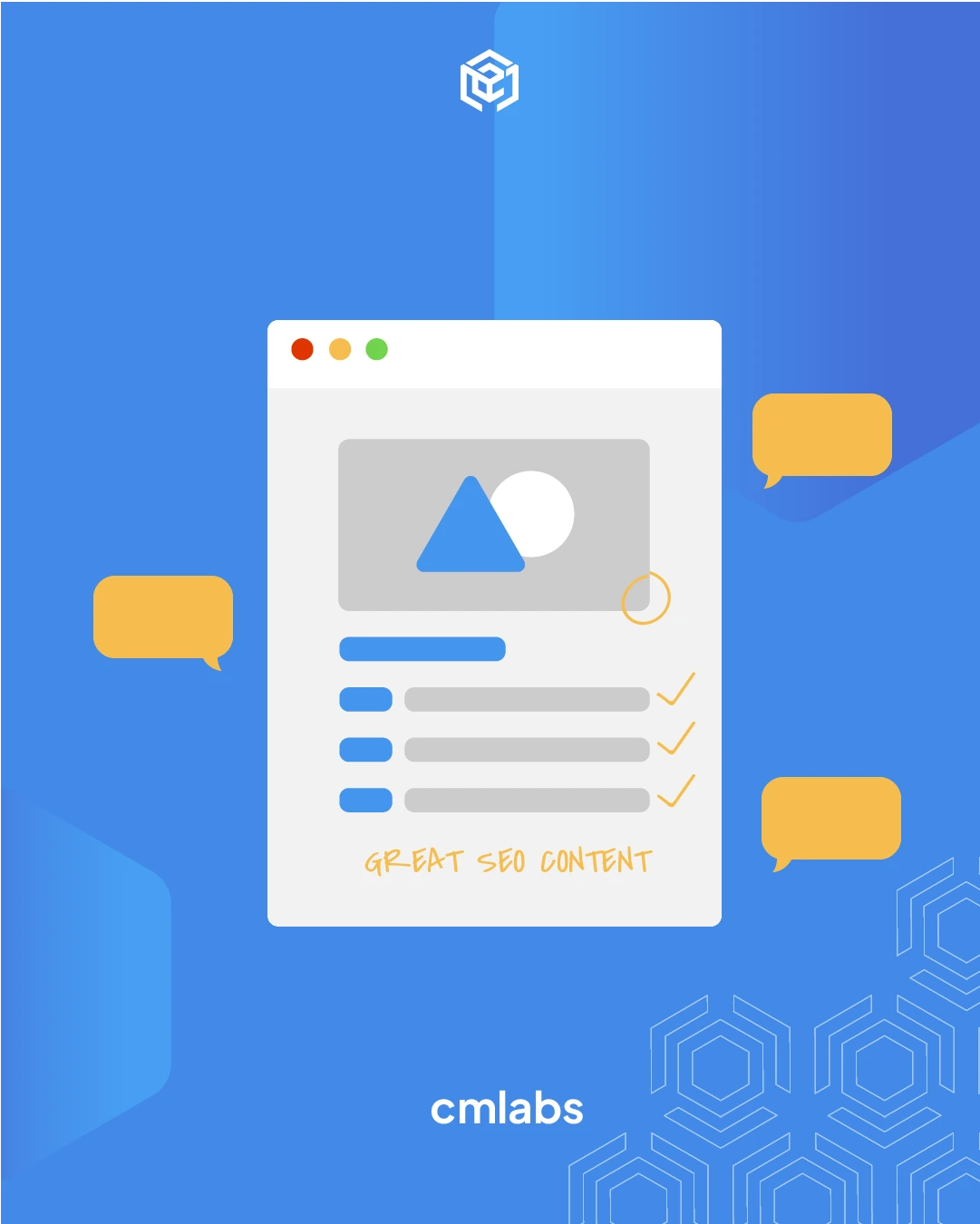We use cookies
This site uses cookies from cmlabs to deliver and enhance the quality of its services and to analyze traffic..
SEO SERVICES
Conduct in-depth technical website audits, strategically develop website projections, and increase your website authority.
ASO SERVICES
Elevate Your App’s Presence with Our Expert ASO Services – Boost Visibility and Drive Downloads!
WRITING SERVICES
We offer a variety of writing services to suit different business necessities. Reach broader audiences or lead specific industries? We've got you covered!
SEOlutions
A unified source of truth!
SEO & Digital Maternity Solution
SEO & Digital Maternity Solution: Leverage Cross-Platform Insights to Elevate Your Strategy with Expert Consultation
SEO & Digital Maternity Solution
Data Solution options:
Starting from Rp200 mio
Reinventing how a company get creative treatments
A new way to get your creative needs done. Agile team, efficient cost, and expedient way in a flexible yet scalable subscription plan!
Creative-as-a-Services
CaaS package options:
Based on Subscription
Pioneer in digital marketing software powerhouse
We’re excited to unveil our new range of Tech Solutions designed to drive your digital success. Whether you’re looking to enhance your website’s performance, streamline your tech stack, or unlock deeper insights from your data, we’ve got you covered.
Starting from Rp250 mio
Our Clients
Research and innovation center for digital transformation
Digital marketing combines technical skills and business knowledge at every stage. For marketing teams, improving budget management efficiency is crucial, as time is an invaluable resource that should be used wisely. At Sequence, we are dedicated to empowering you to optimize efficiency and strategic planning, ultimately enhancing the impact of your digital marketing efforts.
Subscription-based (IDR1,800/keyword)
Our Clients
BeyondSEO
References
SEO Tools for Webmasters
SEO Tools for Writers
SEO Tools
FIND THE SUITABLE PARTNERSHIP FOR YOUR COMPANY
Check out which cmlabs partnership program suits your company
WHITE LABEL SEO
for CorporateYour company is granted exclusive partnership rights to provide SEO services to our important clients, and we will provide a dedicated backend team to support your efforts.
AFFILIATE PROGRAM
for BizdevA new affiliate program is being introduced for skilled marketers and individuals with strong networks, offering commissions of up to 7% for generating profits independently.
DIGITAL AGENCY
for Marketing Partnerscmlabs is an essential partner for digital agencies, providing a unique selling proposition in Search Engine Optimization (SEO).
BACKLINK PARTNERSHIP
for Media / BloggerWe have a vast database of bloggers and media outlets across Indonesia, categorized by region and media type, giving our clients an edge in managing their media and SEO activities.
OFFICIAL TRAINING
We provide ongoing professional development and support to SEO professionals to ensure they are equipped to meet market demands.
JOIN AS CONTRIBUTOR
for Content WriterGreat opportunity for SEO Writers around the world. T&C applied!
ACADEMIC PARTNERSHIP
Through partnerships with universities in Indonesia, cmlabs has helped align academic curricula with industry demands.
Partnership
Sector & Industries
Tell us your SEO needs, our marketing team will help you find the best solution
As an alternative, you can schedule a conference call with our team
Schedule a Meeting?Contact
Survey
We use cookies
This site uses cookies from cmlabs to deliver and enhance the quality of its services and to analyze traffic..
Last updated: Jan 15, 2024

OOP stands for Object-Oriented Programming. This term refers to a programming method that is entirely focused on objects, which consist of data and behavior that can be classified into classes.
One of the advantages of OOP is its composition of components such as classes and objects that interact to create a program.
This Object-Oriented Programming also has the ability to break down complex problems into smaller and manageable parts to improve work efficiency and maximize the final quality of the program.
With OOP, development teams or programmers can enhance work efficiency and maximize the final quality of the developed project.
Additionally, this programming method also become one of the most widely used principles in conjunction with popular programming languages such as Java, Javascript, C++, C#, and Python.
In addition to understanding what is OOP, you also need to know the common terms used in the implementation of Object-Oriented Programming.
Here are some common terms within the methodology along with their explanations:
A function or behavior possessed by an object/class. It describe actions or operations that can be performed by the object (e.g. calculations, changing attribute values, or executing actions).
Data or information possessed by an object/class that characterizes or represents the features of the object. OOP examples: if you have a class "Car," its attributes may include color, speed, and engine capacity.
A blueprint or template that defines the structure and behavior of an object. It contains attributes and methods that will be possessed by the object and is often used as a guide for creating objects.
OOP Examples: If you have a class "Cat," the class would define attributes such as fur color and behavior.
An object is a concrete instance of a class. An object has a state (condition) and behavior defined by its class.
OOP Examples: If "Cat" is a class, then it also has properties, such as being "shy" or having a color of "orange." The characteristics and color of the cat are objects of that class.
Object-oriented programming is a paradigm that defines a program as a collection of objects capable of interacting with each other.
Within OOP, you can conclude that an object is an instance of a class. Overall, this concept helps you organize code in a more structured and modular way. The OOP principles are:
Encapsulation is a principle that involves "encapsulating" data/methods into a single unit and hiding the details and internal implementations of other objects.
It has a highly beneficial feature known as an information-hiding mechanism. This concept allows the development team to expose only the important and relevant functions of an object while keeping its internal implementation details protected.
By using encapsulation, you can control access to the attributes and methods of a class, preventing unwanted modifications and ensuring data integrity.
Inheritance is the concept in which a class can inherit the characteristics and behavior of another class.
The inheriting class is called a subclass, while the class providing the inheritance is called the superclass or base class.
By using inheritance, developers can use or even extend existing code without having to rewrite its framework. Therefore, the principle of inheritance can enhance reusability and enable a more structured class hierarchy.
Polymorphism refers to the ability of an object to have many forms, actions, or behaviors. There are two types of polymorphism in OOP:
Abstraction in object-oriented programming is a concept that allows programmers to focus only on essential features and ignore other distractions.
In OOP, abstraction can be achieved through the use of abstract classes or interfaces. Abstract classes can serve as the basic framework for their subclasses, while interfaces will specify the methods that must be implemented by those classes.
Overall, the principle of abstraction can help create simpler models and facilitate system development by focusing attention on key aspects.
When it comes to software development, object oriented programming (OOP) surely plays a crucial role.
The primary function of OOP is to provide a programming paradigm that enables programmers to design and organize code in a more structured, modular, and understandable way.
Other functions of OOP include:
The object oriented programming method comes with a set of advantages and disadvantages. If you intend to use OOP, consider the following as points of consideration.
Being one of the most popular programming methods, Object-Oriented Programming (OOP) undoubtedly offers many advantageous features, such as:
Despite offering many advantages, you also need to be aware of and consider some disadvantages of OOP, such as:
WDYT, you like my article?
Couldn't find result for "Mulki" try to search with different keyword
Suggestion:
Tell us your SEO needs, our marketing team will help you find the best solution
As an alternative, you can schedule a conference call with our team
Schedule a Meeting?



cmlabs Jakarta Jl. Pluit Kencana Raya No.63, Pluit, Penjaringan, Jakarta Utara, DKI Jakarta, 14450, Indonesia
(+62) 21-666-04470These strategic alliances allow us to offer our clients a wider range of SEO innovative solutions and exceptional service.

Psst! Hey there, SEO Stats and Tools SEO company! If you've ever planned of conquering the Netherlands market, you've come to the right place!